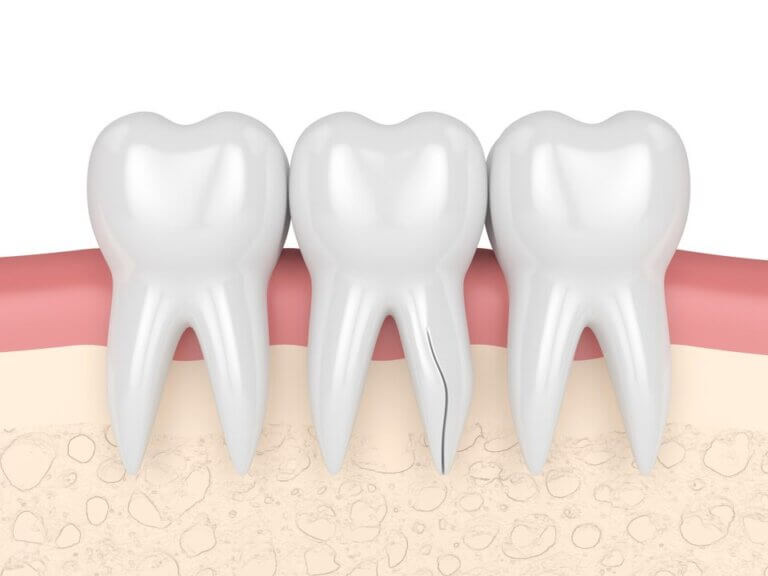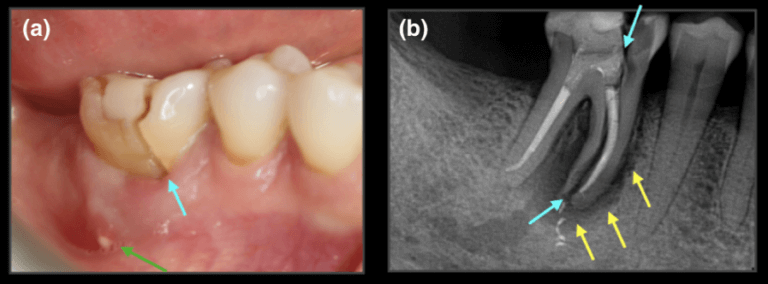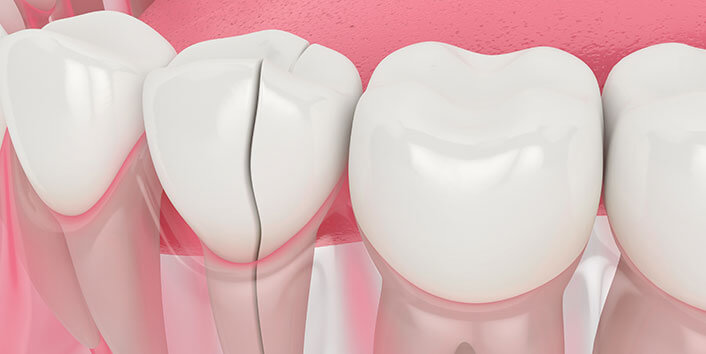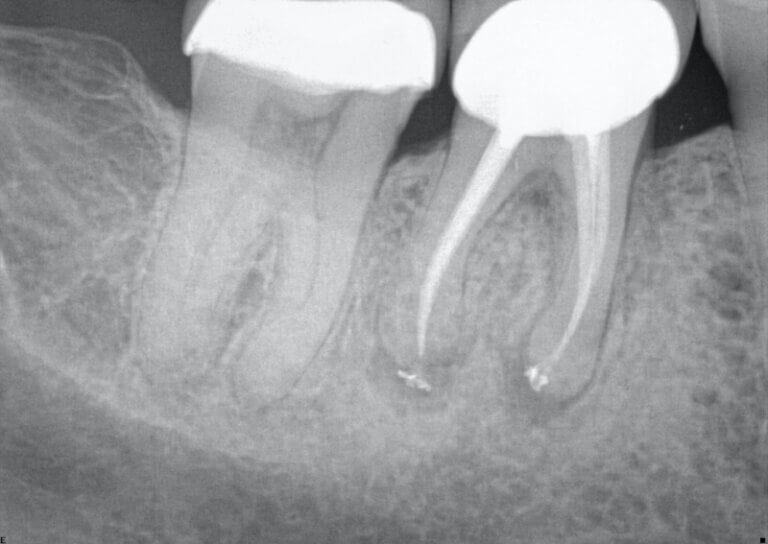Vertical Root Fracture

What Is A Vertical Root Fracture?
A Vertical Root Fracture is a kind of dental problem that’s quite challenging for dentists to deal with. It happens in teeth that have had some root canal treatment, and sometimes in regular teeth. These fractures run vertically along the long axis of the tooth, sometimes originating from the root of the tooth, which makes them hard to spot and treat. Unlike other dental issues, they don’t usually cause any specific symptoms, which makes it even trickier to diagnose them. Often, regular dentists might not notice these fractures, but specialists called endodontists are getting better at finding them. A special kind of 3D X-ray scan called cone beam computed tomography (CBCT) is really good at detecting these fractures.
When a tooth is diagnosed with a vertical root fracture, the usual treatment option is tooth removal. Some studies have tried to fix broken tooth roots, but the success rate varies. It’s crucial to find these fractures early and remove the tooth because it helps keep the jawbone healthy, which is important if you require a tooth replacement option such as dental implants or dental bridges.
Before you contact a Toronto dentist to examine Vertical Root Fracture, there are some things you should know as a patient:
- Why Do I Have A Vertical Root Fracture?
- Signs And Symptoms Of A Vertical Root Fracture
- Treatment Options For A Vertical Root Fracture
- Managing A Vertical Root Fracture Until You Can See The Dentist
If you have questions about Vertical Root Fracture or other dental problems, please contact us for more information
Why Do I Have A Vertical Root Fracture?
Understanding the reasons behind vertical root fractures is essential to prevent and address this dental issue. Some common reasons for Vertical Root Fracture include:
- Endodontic Procedures: Vertical root fractures predominantly occur in endodontically treated teeth. The manipulation of root canals during these procedures can weaken the root structure, increasing the risk of fracture.
- Endodontic Procedures with Screw Posts: Vertical root fractures are more common in teeth that have undergone endodontic procedures, particularly those with screw posts used to support restorations. The placement of screw posts can create internal stress points within the root, greatly increasing the risk of fractures.
- Excessive Biting Force or Trauma: Trauma, such as a hard blow to the tooth, can lead to vertical root fractures. Clenching or grinding teeth (bruxism) can also exert excessive force on the roots over time, increasing the risk.
- Weakened Tooth Structure: Teeth with significant dental restorations, such as large fillings or crowns, may have compromised structural integrity, making them more susceptible to fractures.
- Age and Natural Wear: Over time, teeth naturally experience wear and tear. This can lead to a reduction in the tooth’s structural strength, potentially making them more prone to vertical root fractures.
- Inadequate Restoration: Poorly executed or improperly fitted dental restorations, like crowns or fillings, can create stress points within the tooth, increasing the likelihood of fracture.
If you suspect you have Vertical Root Fracture or are experiencing dental pain, it’s crucial to seek prompt dental care. A dentist will assess your condition and recommend an appropriate treatment plan, which may include root canal therapy or tooth extraction to alleviate the pain and prevent further complications. For more information about Vertical Root Fracture, please contact us.

Signs And Symptoms Of A Vertical Root Fracture
Recognizing the signs and symptoms of a vertical root fracture is crucial for timely diagnosis and treatment. Here are some key indicators to be aware of:
- Sharp, Unexplained Pain: A sudden, sharp pain when biting down or chewing, especially when it’s not associated with any other dental issues, can be a sign of a vertical root fracture.
- Intermittent Discomfort: Pain that comes and goes, often triggered by specific actions like biting or chewing, may suggest a hidden fracture within the tooth.
- Sensitivity to Temperature: Increased sensitivity to hot or cold foods and beverages, especially when the discomfort lingers, can be a sign of dental issues, including vertical root fractures.
- Swelling and Gum Tenderness: Swelling around the affected tooth and tenderness in the adjacent gums may indicate inflammation caused by a vertical root fracture.
- Tooth Mobility: If you notice unusual tooth mobility or a change in how a tooth feels when you bite down, it could be a result of a fractured root.
- Painful Pimple on Gums: The presence of a painful pimple-like bump on the gums near the affected tooth, known as a dental abscess, can be a sign of a vertical root fracture.
- Inconsistent X-ray Findings: Traditional X-rays may not always clearly show a vertical root fracture. However, advanced imaging techniques like cone beam computed tomography (CBCT) can provide a more accurate diagnosis.
- Inconclusive Diagnosis: Sometimes, despite experiencing discomfort and seeking dental evaluation, an exact diagnosis of a vertical root fracture may be challenging due to the lack of definitive symptoms.
If you suspect you have Vertical Root Fracture or are experiencing dental pain, it’s crucial to seek prompt dental care. A dentist will assess your condition and recommend an appropriate treatment plan, which may include tooth extraction to alleviate the pain and prevent further complications. For more information about Vertical Root Fracture, please contact us.

Treatment Options For A Vertical Root Fracture
When diagnosed with a vertical root fracture, there are several treatment options available, depending on the severity and location of the fracture. Here’s a breakdown of these options:
- Tooth Removal: In many cases, when a tooth is affected by a vertical root fracture, extraction is the most practical solution to prevent further complications and maintain oral health.
- Dental Implant: After tooth removal, dental implants offer a reliable and aesthetically pleasing solution. An implant is surgically placed into the jawbone, providing a strong foundation for a replacement tooth.
- Dental Bridge: Dental bridges can be used to replace a missing tooth when adjacent teeth are healthy. The bridge is anchored to the neighboring teeth, providing stability and functionality.
- Denture: Dentures are removable dental appliances designed to replace multiple missing teeth. They are a suitable option when several teeth are affected by vertical root fractures.
The choice of treatment depends on factors such as the patient’s overall dental health, the location of the affected tooth, and individual preferences. It’s essential to consult with a dentist to determine the most appropriate treatment plan for your specific case. Early intervention and a well-informed decision can help restore your dental function and aesthetics effectively. For more information about Vertical Root Fracture, please contact us.

Managing A Vertical Root Fracture Until You Can See The Dentist
If you suspect a vertical root fracture, taking immediate action is crucial. Here are some steps to manage the situation until you can see a dentist:
- Use Over-The-Counter Pain Medication: Over-the-counter pain medication, such as ibuprofen (Advil) or acetaminophen (Tylenol), can help relieve tooth pain or sensitivity from a Vertical Root Fracture. Follow the instructions on the label and do not exceed the recommended dose. Unless you have a health condition that prevents you from taking either ibuprofen or acetaminophen, the absolute maximum dose that I recommend patients take for the worst dental pain is 600 mg ibuprofen combined with 1000 mg acetaminophen every 4 to 6 hours.
- Practice Good Oral Hygiene: Keeping the area around the Vertical Root Fracture as clean as possible can help prevent further damage and alleviate some of the pain or sensitivity. Brush and floss gently around the tooth. Rinsing your mouth with warm salt water or mouthwash can help reduce infection, inflammation and alleviate tooth pain. You can buy any mouthwash available at your pharmacy or health foods store. Alternatively, you can mix a teaspoon of salt in a cup of warm water and swish the solution around your mouth for about 30 seconds before spitting it out.
- Avoid Hot And Cold Foods: Foods that are too hot or too cold can cause tooth sensitivity and pain. Choose room temperature foods so as not to irritate the sensitive broken tooth.
- Avoid Hard And Sticky Foods: Broken teeth are vulnerable to more damage, so it is prudent to avoid hard, crunchy and sticky foods that can weaken the tooth’s structure.
- Avoid Chewing On The Damaged Tooth: Favor using the other side of your mouth as not to further damage the broken tooth.
- Apply A Cold Compress: Apply a cold compress to the affected area to help reduce any swelling and alleviate pain.
Remember that managing a vertical root fracture at home is a temporary solution. Seeking prompt dental care is essential for an accurate diagnosis and effective treatment. Your dentist can assess the extent of the fracture and recommend the most suitable course of action to preserve your dental health. For more information about Vertical Root Fracture, please contact us.

